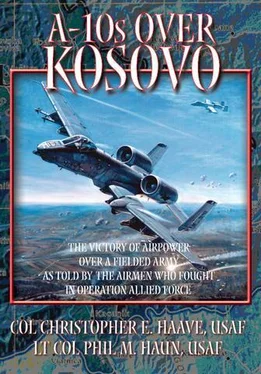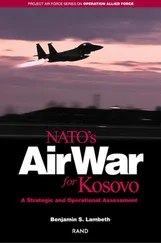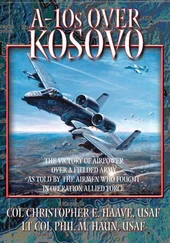I walked into the 510th that morning exactly 30 minutes prior to the time of the mass briefing and exactly 12 hours after leaving the afternoon before. That was as late as I could arrive and still be prepared for the briefing and as early as I could arrive to meet “crew rest” requirements. The hubbub in the hallways took on an ominous tone as a breathless major, who worked in the “Wingtip” (31st AEW’s planning cell), ran up to us with maps in hand. He said, “The CAOC didn’t get approval to use Macedonian airspace to attack Kosovo and you’ll all have to go through Albania. I’ve got some new proposed orbit points on these maps.” This was not good news. The F-15Es would be the only fighters that would be allowed to fly through Macedonian airspace, since they were categorized as air defense. Everyone else—the F-16CJ SEAD patterns, the EA-6B jammer orbits, the two dozen strikers, and us (the AFACs)—would all have to assemble in northern Albania. Moreover, our new plan had to be ready in less than 30 minutes. A mission’s execution often reflects the quality, discipline, and tone set in the briefing. We started the brief with a punctual time-hack—there was no way we were going to begin our first mission command with a late hack and set a less-than-professional precedent! In short, the planning and briefing worked out fine and we launched on time.
The weather, however, was not going to cooperate. Because of the weather and the day-one rules of engagement (ROE), we were unable to engage any targets. Those ROEs attempted to limit risk in an uncertain threat environment by restricting operations to not lower than 17,500 feet and a penetration of not more than 10 miles into Kosovo. Now, 17,500 feet is fine for an aircraft with plenty of thrust and precision-guided munitions (PGM). Its pilot can acquire the aim point using its targeting pod, fly a straight-and-level weapons-delivery pass, and then release its LGBs. A Hog driver, however, must enter a dive and point its nose at the target to expend weapons. At that altitude, a pilot has to enter a steep dive to acquire the target within release parameters. A jet engine’s ability to produce thrust decreases with an increase in altitude, and the thrust required to sustain flight increases with extra weight and drag. It is, therefore, easy to understand why a Hog’s maximum employment altitude is reduced when it’s fully loaded. So our challenge was to find targets from as high an altitude as possible, maneuver the aircraft to put the nose on that target, get a weapons lock-on, launch the missile, and recover without busting the 17,500-foot “hard deck” (minimum altitude, period—not just the minimum weapons-release altitude). Our choice was to operate within this ROE or be slow-speed cheerleaders. On that first mission Biggles and I were working in western Kosovo, south of the town of Pec. I found a hole in the clouds and, using my binoculars, identified a single convoy of four small, dark-green-painted armored cars driving south with military spacing between them. Leaving Biggles up at 22,000 feet, I gingerly pushed the stick forward, lowered the nose, and attempted a Maverick missile lock-on, but my altitude alert sounded just as I brought the armored cars in my TV screen and before I could slew the missile to get a lock. I had set the alert to 1,000 feet above the hard deck, which reflected the amount of altitude I would lose during my dive recovery. Getting a kill on the first sortie was not worth an ROE violation—that sort of breach in air discipline would mean an instant end to our mission leadership. As I cleared Biggles to try a pass, the Serb convoy went under a cloud deck.
That was the best shot anyone had all morning, and the next day, the weather was completely overcast. After surviving the first several missions, we received permission from General Short to lower the ROE hard deck—first down to 15,000 feet and then to 10,000 feet. (One of the themes in chap. 5, ROE will be discussed there by several people at greater length.)
The weather pattern continued to repeat itself and provided us with six unexpected days to practice and perfect our mission leadership. It was challenging for us to keep track of 40-odd aircraft as they flowed into and out of an engagement area protected by enemy air-defense systems and filled with cloud layers. It was a task we learned to accomplish without incident.
The self-initiated pressure to get results was building. We had drilled holes in cloudy skies for seven days without expending any ordnance or slowing down the Serb ground offensive. Finally on 6 April, we got our chance. The Serbs hadn’t started hiding yet. We caught and destroyed several small convoys and other vehicles parked in the open. After landing from that seven-hour sortie, I was pressed to get out the door to comply with crew-rest restrictions (normal crew rest is a 12-hour period that begins when a pilot departs the squadron and ends when he returns for the next day’s mission) but took time to do three important things. First, I distributed the prized bits of weapons arming and release hardware to the ecstatic maintainers and weapons loaders. These swivels, links, and bits of arming wire are attached to the aircraft’s bomb racks and missile rails and arm the weapons when they are released or fired. The maintainers and loaders are proud when their aircraft returns without its weapons and are pleased to get these souvenirs. Second, I briefed the following day’s mission commander on the tactics that worked and those that didn’t. Third, I returned a call General Short had made while I was flying. He was very supportive and asked how the mission had gone. He reminded me to keep the target-identification process rigorous and the “kids” above his ROE altitude. I thanked him for the 10,000-foot hard deck and asked him to consider 8,000 feet. He said he’d think about it.
Evolution of the Airborne Forward Air Controller Mission
After the first week of AFAC sorties, the CAOC changed the name of the CAIFF mission to VMEZ (V=VJ [Serb army] and M=MUP [Serb Interior Ministry police] Engagement Zone). About the same time, we were allowed to seek out and destroy targets throughout Kosovo, but still without using Macedonian airspace. VMEZ then changed in mid-April to KEZ, and on 15 April, we finally received clearance to attack Serbia and Kosovo through Macedonian airspace. (For simplicity’s sake, the air campaign against fielded forces is hereafter called “KEZ operations” and the area in Kosovo and southeastern Serbia where we engaged fielded forces is “the KEZ.”)
During the first week of OAF, daily KEZ operations were limited to a single three-hour period from 0600 to 0900. After our early successes, the CAOC expanded KEZ operations to two three-hour daytime periods, with F-16CG FACs from Aviano joining us. Unfortunately, the Serbs were quick to adapt their operations to ours. We soon noticed that the Serb army simply hid its armored vehicles while we were roaming overhead, and then wreaked havoc on the Kosovar civilians when we left. We saw a critical need to increase our ability to influence events on the ground and sent a proposal to the CAOC to expand our operations to near-continuous coverage. That proposal required more aircraft (how and where we got those Hogs is discussed at length in chap. 3, whose theme is beddown). Eventually, with more A-10s and carrier-based F-14 AFACs, KEZ operations reached a cruising speed of 18 hours daily in late April, divided into three-hour periods. There were two “holes” in the schedule around sunset and sunrise, due to limitations in the availability of some key assets (jammers and SEAD). This 18-hour coverage continued until the end of hostilities. The F-16CGs did most of the FACing at night and were assisted by ANG A-10s after they arrived. At night, A-10s, F-16CGs, and British GR-7s flew with night vision goggles.
Читать дальше












